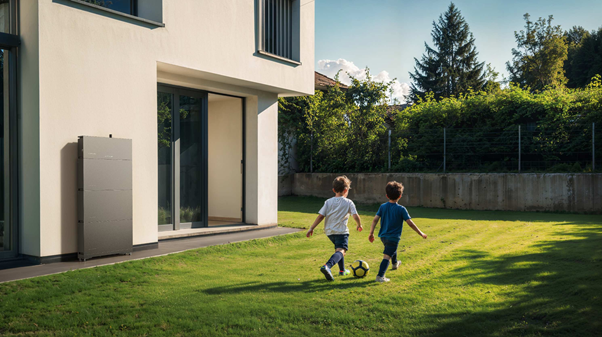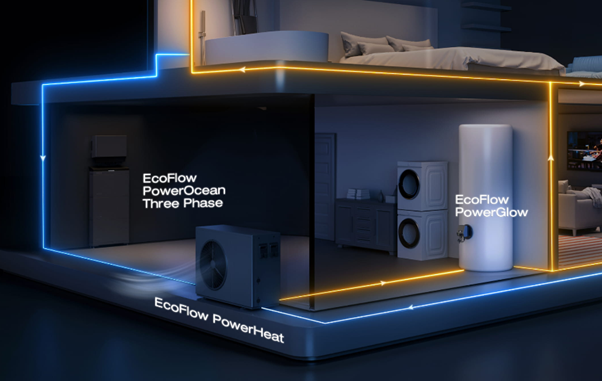How Much Power Does a Solar Panel Produce?
A solar panel’s power production depends on several factors, from its location, orientation, and tilt to the type of panel, efficiency rating, and sun irradiance. You can calculate your solar panel’s output in watts or watt-hours and measure it by daily, monthly, or per-square-metre performance.
Below, we outline the various ways to calculate solar output and highlight the many factors that impact performance. We also offer a solution for optimising your system if your panels generate more energy than you can use.
What Is Solar Panel Output?
Solar panel output is expressed in watts (W); the higher the wattage, the more electricity it produces. Other conditions, such as location, roof angle, and tilt/orientation, will also impact the output.
For example, a 350W panel produces that much electricity under ideal conditions. The reality may be slightly different. Panels can typically produce about 75% of the listed power rating. In this case, the panel may only produce an average of 262.5W.
You can also measure output in kWh to measure how much energy you use over time. You’ll often find this measurement somewhere in your energy bills.
So, for an average three-bedroom household that uses 2,700 kWh of electricity annually, you’d need 10 x 350W solar panels to produce enough power to meet your energy consumption needs.
How To Calculate Solar Panel Output
You can measure solar panel output in several ways: total power in watts, kilowatt-hours over time, or the panels' real-world performance under varying conditions.
To understand the panels’ power in watts, you can find the wattage rating listed on the panel. This is the maximum power it can output in ideal conditions. Manufacturers determine this rating during their standardised testing, exposing the panel to an irradiance (sun intensity) of 1kW/m^2 with a cell temperature of 25ºC.
A 20% efficiency panel would have a 200W rating because it can convert 20% of the 1kW to usable electricity.
As for kilowatt-hours, this will help you find a broader metric of how much energy is used over time. A kilowatt-hour represents how much energy a 1kW device would use if it ran for a full hour. We can calculate how much energy a 300W panel operating at maximum capacity would use over three hours in optimal conditions.
300W x 3 hours = 900Wh, or .9kWh.
These measurements assume ideal conditions, which is not always possible in real-world applications. Other factors come into play when solar panels are installed on a home. More on that later.
How Much Power Do I Need From Solar Panels in the UK?
You must understand your energy consumption to know how much power your home needs from its solar array in the UK. Look at your past energy bills or take notes from your smart meter to see how much electricity you use weekly or monthly. You can also find statistics on average energy use in the UK to get you started.
For example, Ofgem reports that the typical annual electricity use in kWh for a flat or one-bedroom house with 1-2 occupants is around 1,800 kWh annually or 150 kWh average per month. For a medium-use home with 2-3 bedrooms and 2-3 occupants, that estimate rises to 2,700 kWh per year. A high-consumption home with four or more bedrooms and 4-5 occupants can use as much as 4,100 kWh per year.
If your numbers are far from these estimates, you may be a high-energy user. If you think your calculations are incorrect, contact your electricity provider for more accurate figures.
Once you know how much power your solar panels produce, you can determine the size of the solar battery you’ll need to store excess energy for later use. To figure this out, calculate how much of the produced electricity you can use and how much excess you’ll have for solar battery storage.

What Affects the Power Output of Solar Panels?
Here are several factors that can affect the actual power output.
System Size
The system size will be the primary determinant of your solar panel output. The more panels and the higher each panel is rated, the more energy output you’ll get. A more robust system will consistently produce more than a smaller system. However, a lot more goes into it that can reduce the total output of your panels.
Panel Orientation and Location
The location and orientation of your solar panels play a big part. Are they oriented toward the sun to get maximum exposure? Are they tilted at the right angle? Where is your home located? Homes in sunny areas will get more sunlight and thus produce more electricity than homes in regions known for cloudy, dreary weather. Most of these things are out of your control and depend on the geographic location of your home and the angle and direction of your roof.
Shade, Dirt, and Debris
Photovoltaic (PV) panels must be free of dirt and debris and have minimal shade interference to absorb as much sunlight as possible. Installing your array where it will be blocked by the shade of trees, plants, or other buildings will hinder its performance. Try to trim trees and remove shrubbery that may reduce your panel’s efficiency.
Dirt and debris can also block sunlight, so regular maintenance is critical. Clean your panels at least twice a year (or more if you live in an area prone to dust, pollen, or storm debris) to ensure they work as efficiently as possible.
Time of Year
Summer tends to be better for PV production, with more sunlight translating to more power production. However, too hot temperatures (above 25ºC) may reduce performance.
Panel Type
Monocrystalline panels are much more productive than polycrystalline or thin-film construction. They’re the most common type used for domestic and commercial arrays and feature a sleek and uniform appearance. Monocrystalline efficiency ratings range from 15% to 22%.
Irradiance
Irradiance is the sunlight’s intensity or brightness at a specific place and time. It’s measured in watts per square meter. The average irradiance in the UK is around 101 W/m^2, but it can spike higher, especially in the summer.
Panel Efficiency
A high-efficiency panel (20%+) converts more energy per watt of sunlight into usable electricity than a moderate- or low-efficiency panel (~15%).

What Happens If My System Produces More Electricity Than I Can Use?
If your PV array system produces more electricity than you can use, don’t let it go to waste. If you’re connected to the grid, the extra energy will be sent back to the grid, but you can save it for yourself to use on cloudy days or at night. We recommend pairing your solar panel system with a battery backup for your home. Choose either the EcoFlow PowerOcean (Single-Phase) for lower household power needs, the EcoFlow PowerOcean (Three-Phase) for higher energy consumption, or the EcoFlow PowerOcean DC Fit, which can be retrofitted to your existing setup.
Frequently Asked Questions
- How Much Power Does 1 Solar Panel Produce per Day?This answer varies depending on the panels’ size, location, panel type, sunlight received, and other factors. However, the average solar panel can produce between 1 and 4 kWh per day. Check the average wattage of your panel and consider what other factors may impact the total production.
Final Thoughts
Optimising your solar array to include the correct number of panels that can generate an appropriate amount of electricity will help you manage the costs of your solar power system. Ideally, your system will meet your energy consumption needs with a small buffer for expansion, but if your system generates far more than you can consume, you still have options. Rather than let that excess energy go to waste, capture it and store it for use during dark days and nights with a home battery system such as the EcoFlow PowerOcean (Single-Phase) or EcoFlow PowerOcean (Three-Phase).


%20(1).png)

